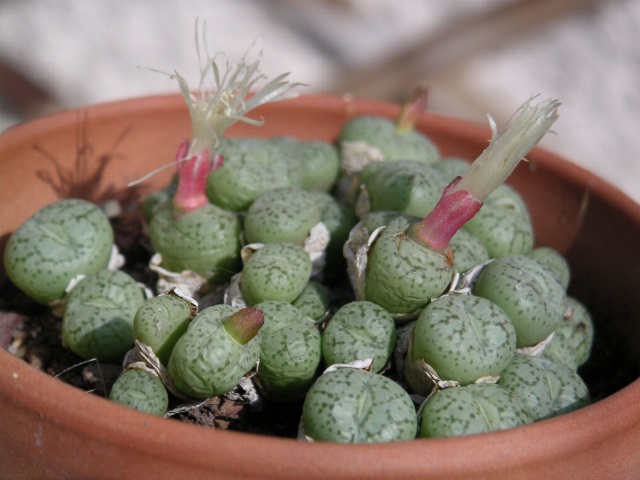Conophytum on:
[Wikipedia]
[Google]
[Amazon]



 ''Conophytum'' is a
''Conophytum'' is a




 ''Conophytum'' is a
''Conophytum'' is a genus
Genus ( plural genera ) is a taxonomic rank used in the biological classification of living and fossil organisms as well as viruses. In the hierarchy of biological classification, genus comes above species and below family. In binomial nom ...
of South African and Namibian succulent
In botany, succulent plants, also known as succulents, are plants with parts that are thickened, fleshy, and engorged, usually to retain water in arid climates or soil conditions. The word ''succulent'' comes from the Latin word ''sucus'', meani ...
plants that belong to the family
Family (from la, familia) is a group of people related either by consanguinity (by recognized birth) or affinity (by marriage or other relationship). The purpose of the family is to maintain the well-being of its members and of society. Idea ...
Aizoaceae
The Aizoaceae, or fig-marigold family, is a large family of dicotyledonous flowering plants containing 135 genera and about 1800 species. They are commonly known as ice plants or carpet weeds. They are often called vygies in South Africa and N ...
. The name is derived from the Latin ''conus'' (cone) and Greek ''phytum'' (plant). The plants are also known as knopies (buttons in Afrikaans
Afrikaans (, ) is a West Germanic language that evolved in the Dutch Cape Colony from the Dutch vernacular of Holland proper (i.e., the Hollandic dialect) used by Dutch, French, and German settlers and their enslaved people. Afrikaans gr ...
), waterblasies (water blisters in Afrikaans), sphaeroids, conos, cone plants, dumplings, or button plants.
Taxonomy
The genus is sometimes wrongly referred to as ''Conophyton'', the name thatAdrian Hardy Haworth
Adrian is a form of the Latin given name Adrianus or Hadrianus. Its ultimate origin is most likely via the former river Adria from the Venetic and Illyrian word ''adur'', meaning "sea" or "water".
The Adria was until the 8th century BC the mai ...
suggested in 1821: "If this section proves to be a genus, the name of Conophyton would be apt". However, this was too tentative to establish a validly published generic name and also, Haworth himself neither adopted it nor accepted the genus. The genus was neither recognised nor validly named until the name ''Conophytum'' was published 101 years later.
Description
''Conophytum'' species are dwarf cushion-forming or single-bodied succulents. Members of the genus are tiny plants with succulent leaves ranging from 1/4" to 2" in length. These leaves are partially or entirely fused along their centers. Each leaf pair (together referred to as a body) ranges in shape from "bilobed" to spherical to ovoid to tubular to conical. Some species have epidermal windows on the top of their leaves. To the naked eye the epidermis ranges from very smooth to slightly rough to hairy, depending on the microscopic epidermal cell shape and structure. In their normal, natural state each stem has only one pair of leaves at a time though one plant may have dozens of stems and thus dozens of leaf pairs. When very heavy rains come to their native habitat they may grow luxuriantly and develop two leaf pairs per stem simultaneously; this is called "stacking up" of the leaves. The plants grow very slowly; depending on the species, a 50-year-old plant might not be bigger than awalnut
A walnut is the edible seed of a drupe of any tree of the genus ''Juglans'' (family Juglandaceae), particularly the Persian or English walnut, '' Juglans regia''.
Although culinarily considered a "nut" and used as such, it is not a true ...
.
Cultivation
Several species of ''Conophytum'' are found in cultivation. In temperate regions they are best grown in a specialist medium with the protection of glass, as they do not tolerate temperatures below .Conservation
Recently several species have been threatened with extinction due to mining and poaching from the wild for the black market. These plants are mainly sold to collectors in Asian countries, where there has been a high demand for them. In June 2021, police arrested a dozen men at a farm in the Western Cape for possession of 4,000 '' Conophytum acutum''; this came as a surprise as scientists thought there were only about a thousand of the plants in the wild and none on the farm in question. Teams at theKirstenbosch Botanical Garden
Kirstenbosch is an important botanical garden nestled at the eastern foot of Table Mountain in Cape Town. The garden is one of 10 National Botanical Gardens covering five of South Africa's six different biomes and administered by the South Af ...
are collecting and categorising seeds from ''Conophytum'' and other succulents in partnership with the Millennium Seed Bank
The Millennium Seed Bank Partnership (MSBP or MSB), formerly known as the Millennium Seed Bank Project, is the largest ''ex situ'' plant conservation programme in the world coordinated by the Royal Botanic Gardens, Kew. After being awarded a Mi ...
.
Species
This is a list of species in the genus ''Conophytum''.Hammer, S.(2002) ''Dumpling and His Wife: New Views of the Genus Conophytum'' EAE Creative Colour Ltd.
References
Aizoaceae genera Flora of Namibia Flora of South Africa Flora of the Cape Provinces Succulent plants Taxa named by N. E. Brown {{Aizoaceae-stub